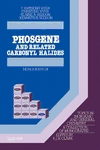Download Phosgene and Related Carbonyl Halides PDF Free - Full Version
Download Phosgene and Related Carbonyl Halides by Ryan T.A., Ryan C., Seddon E.A. and Seddon K.R. in PDF format completely FREE. No registration required, no payment needed. Get instant access to this valuable resource on PDFdrive.to!
About Phosgene and Related Carbonyl Halides
Phosgene, COCl2 is a C1 chemical of major industrial importance. The annual production, worldwide, is more than 1 million tons; 90% of which is used in the manufacture of isocyanates and of polyurethane and polycarbonate resins. Phosgene is also extensively used as a synthetic reagent in organic chemistry, in particular in the preparation of acyl chlorides, chloroformate esters, organic carbonates and carbamoyl chlorides.Although more than 7000 papers have appeared on phosgene and some 1000 papers on its analogues, this is the first book on these interesting chemicals. It presents a critical treatise of phosgene, ranging from its discovery and subsequent use as a war gas to some potential applications of the material into the 21st century. It includes chapters on biological effects and industrial hygiene; on synthesis, formation and manufacture; analysis, uses, environmental effects, and physical and thermodynamic properties. Reactions with organic and inorganic materials are described. Four of the seventeen chapters are devoted to a description of the carbonyl halides (especially carbonyl difluoride) related to phosgene, and a special section deals collectively with the electronic structures of carbonyl halide molecules.Featuring the first-ever comprehensive discussion of the medical effects of phosgene poisoning and the most modern methods of treating exposure victims, the book will be of interest to historians and militarists and those working in the chemical industries (heavy chemicals, agricultural and pharmaceutical), university libraries, hospitals, medical research centres, museums, environmental research centres, poison units and health and safety institutions world-wide.
Detailed Information
| Author: | Ryan T.A., Ryan C., Seddon E.A. and Seddon K.R. |
|---|---|
| Publication Year: | 1996 |
| Pages: | 979 |
| Language: | English |
| File Size: | 47.955 |
| Format: | |
| Price: | FREE |
Safe & Secure Download - No registration required
Why Choose PDFdrive for Your Free Phosgene and Related Carbonyl Halides Download?
- 100% Free: No hidden fees or subscriptions required for one book every day.
- No Registration: Immediate access is available without creating accounts for one book every day.
- Safe and Secure: Clean downloads without malware or viruses
- Multiple Formats: PDF, MOBI, Mpub,... optimized for all devices
- Educational Resource: Supporting knowledge sharing and learning
Frequently Asked Questions
Is it really free to download Phosgene and Related Carbonyl Halides PDF?
Yes, on https://PDFdrive.to you can download Phosgene and Related Carbonyl Halides by Ryan T.A., Ryan C., Seddon E.A. and Seddon K.R. completely free. We don't require any payment, subscription, or registration to access this PDF file. For 3 books every day.
How can I read Phosgene and Related Carbonyl Halides on my mobile device?
After downloading Phosgene and Related Carbonyl Halides PDF, you can open it with any PDF reader app on your phone or tablet. We recommend using Adobe Acrobat Reader, Apple Books, or Google Play Books for the best reading experience.
Is this the full version of Phosgene and Related Carbonyl Halides?
Yes, this is the complete PDF version of Phosgene and Related Carbonyl Halides by Ryan T.A., Ryan C., Seddon E.A. and Seddon K.R.. You will be able to read the entire content as in the printed version without missing any pages.
Is it legal to download Phosgene and Related Carbonyl Halides PDF for free?
https://PDFdrive.to provides links to free educational resources available online. We do not store any files on our servers. Please be aware of copyright laws in your country before downloading.
The materials shared are intended for research, educational, and personal use in accordance with fair use principles.

